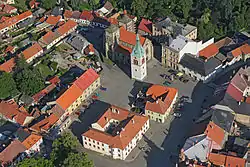Kouřim | |
|---|---|
 Main square | |
 Coat of arms | |
 Kouřim Location in the Czech Republic | |
| Coordinates: 50°0′11″N 14°58′38″E / 50.00306°N 14.97722°E | |
| Country | |
| Region | Central Bohemian |
| District | Kolín |
| First mentioned | 1261 |
| Government | |
| • Mayor | Luboš Čepelák |
| Area | |
| • Total | 14.40 km2 (5.56 sq mi) |
| Elevation | 268 m (879 ft) |
| Population (2023-01-01)[1] | |
| • Total | 1,985 |
| • Density | 140/km2 (360/sq mi) |
| Time zone | UTC+1 (CET) |
| • Summer (DST) | UTC+2 (CEST) |
| Postal code | 281 61 |
| Website | www |
Kouřim (Czech pronunciation: [ˈkour̝ɪm]; German: Kaurzim, Kaurzin, Kaurim) is a town in Kolín District in the Central Bohemian Region of the Czech Republic. It has about 2,000 inhabitants. The historic town centre is well preserved and is protected by law as an urban monument zone.
Administrative parts
The village of Molitorov is an administrative part of Kouřim.
Geography
Kouřim is located about 15 kilometres (9 mi) west of Kolín and 31 km (19 mi) east of Prague. It lies in a flat agricultural landscape of the Central Elbe Table.
History


The first written mention of Kouřim is in a deed of Ottokar II of Bohemia from 1261. The royal town of Kouřim was probably founded by Wenceslaus I between 1223 and 1250. At the turn of the 15th and 16th centuries, the town experienced an unprecedented prosperity, and at the end of the 16th century there were over 2,000 inhabitants (which is more than today).[2]
A great disaster for the town was the Thirty Years' War, which ended Kouřim's status as one of the most important towns in the Czech Kingdom. The population declined by 75% and it lost the town privileges until 1740, when it was renewed by Emperor Charles VI.[2]
In 1881, the railway to Pečky was built. At the end of the 19th century, Kouřim was with about 3,000 inhabitants at its peak. In the 20th century, especially at the end of the 1960s, the town stagnated and has become a periphery. It completely lost its cultural identity, originally determined by an extremely strong historical tradition. Thanks to this, however, the town has preserved its "genius loci", which has become an advantage for tourism and filmmaking.[2]
Demographics
|
|
| ||||||||||||||||||||||||||||||||||||||||||||||||||||||
| Source: Censuses[3][4] | ||||||||||||||||||||||||||||||||||||||||||||||||||||||||
Sights
Stará Kouřim ("Old Kouřim") are remains of a gord of the Slavník dynasty on a hill east of town. It dates from the 9th or 10th century. With an area of 44 ha (110 acres), it was one of the largest fortified settlements in period from the late Stone Age to the early Middle Ages. An educational trail leads through the remains of the gord. Archaeological finds from the site are on display in the Kouřim Museum.[5][6]
The Church of Saint Stephen dates from the second half of the 13th century. It is a prominent example of early Gothic architecture.[7]
Town walls in Kouřim dates from the 13th–16th century. They are 1,250 metres (4,100 ft) long in circumference. In addition to a large part of the walls, one of the four original gates, called the Prague Gate, has been preserved. It is considered to be the best preserved early Gothic town gate in the Czech Republic.[8]
Open-air Museum Kouřim shows various regional types of vernacular architecture from the 17th to the 19th century. The museum is administered by the Regional Museum in Kolín.[9]
In popular culture
Kouřim is a popular place for Czech filmmakers. The films shot here include Patrimony, Hastrman and Nesmrtelná teta.[10]
Notable people
- František Vejdovský (1849–1939), zoologist
- Evžen Linhart (1898–1949), architect and designer
References
- ↑ "Population of Municipalities – 1 January 2023". Czech Statistical Office. 2023-05-23.
- 1 2 3 "Kouřim" (in Czech). Cesty a památky. Retrieved 2021-06-29.
- ↑ "Historický lexikon obcí České republiky 1869–2011 – Okres Kolín" (in Czech). Czech Statistical Office. 2015-12-21. pp. 5–6.
- ↑ "Population Census 2021: Population by sex". Public Database. Czech Statistical Office. 2021-03-27.
- ↑ "Hradiště Stará Kouřim" (in Czech). CzechTourism. Retrieved 2022-06-09.
- ↑ Berend, Nora; Urbańczyk, Przemysław; Wiszewski, Przemysław (2013). Central Europe in the High Middle Ages: Bohemia, Hungary and Poland, c.900–c.1300. Cambridge University Press. p. 83. ISBN 978-1-107-65139-5.
- ↑ "Historie – středověk" (in Czech). Kostel sv. Štěpána v Kouřimi. Retrieved 2022-06-09.
- ↑ "Městské opevnění v Kouřimi" (in Czech). CzechTourism. Retrieved 2022-06-09.
- ↑ "The Museum". Open-air Museum Kouřim. Retrieved 2022-06-09.
- ↑ "Město a film" (in Czech). Město Kouřim. Retrieved 2021-06-29.